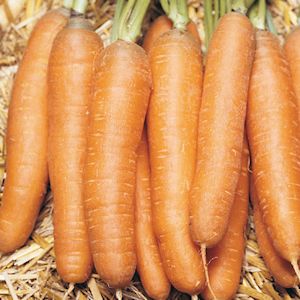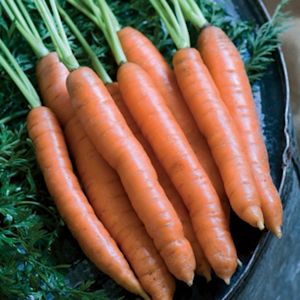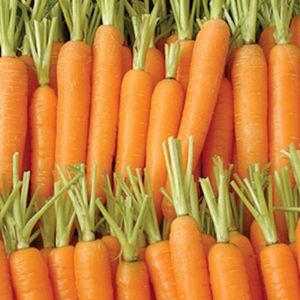Planting:
To produce the best crop possible, double-dig your planting area or build up a raised bed. Deep, loose, and fertile sandy loams and peat soils with good moisture-holding capacity grow the straightest and smoothest roots. Loose, rock-free soil is the goal. Rake the soil free of lumps and stones. If you have heavy soil, add plenty of mature compost. We like using Smart pots and our potting soil.
Start sowing this cool-weather crop 3 weeks before the last expected frost; plant again every 2 to 3 weeks after that. Plant carrots intended for winter storage about 100 days before expected fall frost.
Sow 3/4-1″ apart (about 30 seeds/ft.), 1/4- 1/2″ deep, in 2″ wide band, or single rows 16-24″ apart. For minimum soil compaction, use raised beds with 2 or 3 rows 16-24″ apart, beds 5-6′ on center. Sprinkle the soil surface to keep moist. Don’t allow soil to crust before the emergence of seedlings which takes 1-3 weeks, depending on temperature and moisture. We recommend using pelleted seed for easier placement, better germination and less thinning. If necessary, thin young seedlings to 3/4-2″ apart, depending on root size desired. Keep weed-free by tine weeding and shallow hoeing. To prevent greening, cover exposed crowns.
As the seedlings develop, gradually apply mulch to maintain an even moisture level and reduce weed problems. It’s best never to let young carrot plants dry out. However, if the soil dries out completely between waterings, gradually remoisten the bed over a period of days; a sudden drenching may cause the roots to split. Carrots’ feeder roots are easily damaged, so hand pull any weeds that push through the mulch, or cut them off just below the soil surface. Cover carrot crowns, which push up through the soil as they mature, with mulch or soil to prevent them from becoming green and bitter.
Harvesting:
Carrots become tastier as they grow and as the soil gets cooler. You can start harvesting as soon as the carrots are big enough to eat, or leave them all to mature for a single harvest. Generally the best harvest period lasts about 3 weeks (longer in cool, fall weather), after which time the roots may crack or the taste and appearance may decline. Dig your winter storage crop before the first frost on a day when the soil is moist but the air is dry. Since spading forks tend to bruise roots, hand-pull them, loosen the soil with a trowel before you pull. Watering the bed before harvesting softens the soil and makes pulling easier.
Storage:
To save harvested carrots for winter use, prepare them by twisting off the tops and removing excess soil, but don’t wash them. Layer undamaged roots (so they’re not touching) with damp sand or peat in boxes topped with straw. Carrots store best at 32°F (0°C) and 95% relative humidity. Or store your fall carrot crop right in the garden by mulching the bed with several inches of dry leaves or straw.
Varieties
75 days
Ideal storage carrot. Medium-long, 7-8″”, roots are uniform, thick, slightly tapered, and blunt. The flavor is good fresh, and tops the charts after long-term storage. A great choice for fall and winter harvest. Heavy, tall tops.”
56 days
Consistently sweet, early variety. A favorite for early sowing and harvest during warm and hot weather, when growing sweet carrots is most difficult. The 5½-6½””, cylindrical, blunt roots are very smooth, brittle, tender, and crisp with deep orange color. Harvest at baby or full size.”
58 days
Ideal for overwintering. A specialized variety with a very sweet taste when sown in fall for winter harvest. Sow in the coldframe or mini-greenhouse for winter harvest. Up to 7″” cylindrical, smooth, blunt roots with strong tops.”



